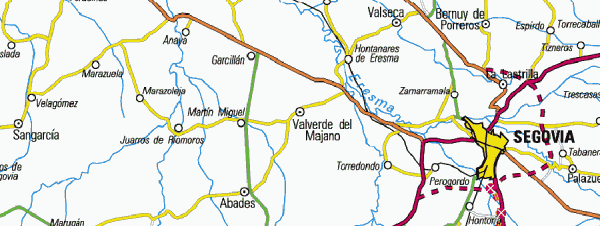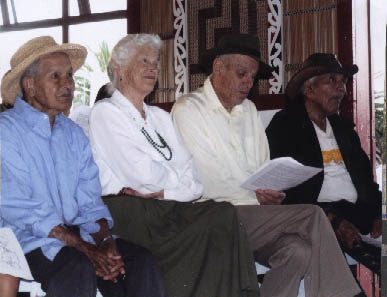History
All we really know about this important ancestor is expressed in the poem ‘The Manuel José Enigma’ written by Hal Hovell of Te Araroa in 1981.
The Manuel José Enigma
You came to live on foreign shores a Castilian man alone,
Landed at Port Awanui, at Taumata made your home
You gave away a whaling life, at trading tried your hand,
A solitary Spaniard, in a raw, unbroken land.
Manuel José, where did you come from? What did you leave behind?
Were the seas you travelled troubled, the times hard or kind?
What lies hidden in your past, forgotten with passing time?
Shame or bloody glory, pain or violent crime?
What made you leave your native shores to sail the southern seas?
Perhaps love unrequited, or some bold adventurous creed?
Now in the 1980s your descendents live far and wide
In this land that you adopted, under the Southern skies.
Though they descend from five wives, the family ties are strong
And the Spanish blood you gave them provides the common bond.
You remain their enigma, the Paniora with no past.
At Awanui, the last living link, an olive tree stands fast.
They have gathered in your memory, and raised a cross on high,
On the hill at Taumata within sight and sound of tide.
How many times did you stand there, and view that lonely scene?
Was there regret and sorrow for what you’d left across those seas?
Whatever thoughts filled your mind as you stood there alone,
We, your surviving family, are glad you made it home.
And we will stand here filled with pride and dignity as long
As the Paniora Blood remains to keep the family strong
Why José and not Josef? José is Spanish for Joe and it has long been a pet name for this Tipuna (always pronounce the ‘J’ as an ‘H’ .. Manuel Hosé. The vowels are pronounced as in Maori).
References
The following references to our forebear give us a bit more information about him:
He was a whaler. His ship was the ‘Elizabeth’. He left his ship and became a shore whaler and later a trader at Awanui on the East Coast of New Zealand.
- 1850: Porourangi treated him as head among the Waiapu traders and by 1870 he had established a second store at Ohinewaiapu.
- 1875: Poverty Bay Standard…’Several marriages have taken place here, and with the last knot to be tied by the Magistrate, who is also the District Registrar, both the bridegroom and bride, being Castilian on the paternal side. (Marriage of Manuel Lima and Peti, daughter of Manuel Josef, which took place on 17 January, 1875). Maria Lima Rosa, the mother of Manuel Lima’s father, was Spanish.
- 1934: Evidence given in the Maori Land Court by Joe Lima, eldest son of Manuel Lima.

- 1948: Notes from McKay’s Historic Poverty Bay and the East Coast ‘A Spaniard, born in America, was among the earliest traders in the Waiapu district. His name was Manuel and was known to the natives as Manuera. His principal wife was Tapeta, (Herekaipuke).
- 1951: In a letter to his daughter, Buddy Leatherby, Chris Lima, son of Tom Lima, wrote: He was a Spaniard named Manuel José… He came from Balu in central Peru and his forebears came from Segovia in Spain. Note: There is no such place in Peru as “Balu”. It is believed to be a mispronunciation of “Peru” by a non-Englisfh speaking person. Chris Lima was noted for his knowledge of history and whakapapa in his whanau. A recognised scholar, he was widely read. Spanish has been the language of Peru since the 16th Century.
- Speaking of her grandfather, Mary Hovell recalled that he came to school to teach about geography. Mary attended Port Awanui School in 1893.
- Tapita Kura Brown, granddaughter of Meri Manuel, was named after Manuera’s wife. She was told by her elders that her name ‘Tapita’ was not Maori but Spanish and that the stress ought to be on the second syllable. We are told that Tapita was the name given by Manuel to his principal wife, Te Herekaipuke. Ereti Collier recalled that he loved his little wife. She was small and dainty. A visitor from Argentina, seeing the name “Tapita” remarked Oh, he called his wife “Tapita”. When asked she explained that ‘tapita’ meant a thing that one was fond of or cherished.
- Evidence of olive tree grown on the site of his store at Port Awanui
Was Manuel José pure Spanish?
How often have we heard over the years, Victor Rickard refer to his grandmother Peti Lima, as “that old Inca”? And why “Inca”? Manuel José was Spanish wasn’t he? and who on the Coast would have known about the Inca? Certainly Victor always uttered these words with a sense of devilment, but it was well known that Victor, son of Peti Lima’s youngest daughter Juliana, learned much from the old people and his knowledge of the family was legendary.
The origins of Manuel José are still shrouded in mystery and even after 160 years the answer still eludes us. Who was he?

It is time to reassess these fragments of information that have come our way.
And so we return to Victor. Was “Inca” a word he absorbed without realising it while listening to the talk of the old people?
The Inca are, of course, the indigenous people of Peru. Study the faces of Manuel’s daughters. Notice their high cheek bones and their eyes. These are also features of the South American Indian. Manuel himself is said to have been tall and strong, with reddish hair, wave upon wave better than a judges wig, and his eyes were green. He was fair of skin but there was a darkness about it that hinted of the duskiness of Spain. And the photo of Raupata show’s that he favoured his father, but Manuel’s daughter show very different features.
Although Peru is on the west coast of South America and Brazil on the east, the Spanish and Portuguese languages spoken there have much in common and tradition says that Manuel and his Portuguese son-in-law from Brazil used to converse together. It is only to be expected that both being from South America there would be reminiscing, as there always is with the exile, and in the course of conversation each would learn much about the other’s background. So … perhaps the references to the Inca have been passed on by Manuel Lima himself.
Harry K. Hovell, the husband of Peti Lima’s eldest daughter Mary, gave the nickname “Ayacanora” to at least two of his granddaughters who showed more than others their Latin American heritage. Ayacanora was the name of the half-Spanish half-Inca heroine of Charles Kingsley’s “Westward Ho”
Note: Evelyn, daughter of Tom Hovell and Grace, daughter of Ethel Tawhiri.
Over the years, these Inca references have been brushed over, but ought they to have been? Could those long dead grandparents have had vital knowledge of José that we, in our disinterest in genealogy at the time failed to pick up?
**Since the time that the above information was recorded we have found out more about Manuel Jose. Much more!**
We have been given the wonderful gift of his birth date and place in Spain, AND the names of his parents!!
In September last year, Diana Burns, a journalist who has for some years now been interested in our family (see article “The Spanish Coast” Listener, Feb 2, 2002) wrote to Bob and Vivienne McConnell to tell them there is a Small town called Valverde near Segovia in Spain. In that town there was once a young man named Manuel, whose father was called Jose, and who took his father’s name as his own surname – Manuel Jose.
Manuel Jose’s birthplace revealed
by Alice Te Puni – Friday, 24 February 2006
A romantic true tale of Spanish links lost and now found has unfolded in the East Coast’s rural Rangitukia.
The identity of Spaniard Manuel Jose, a trader at Port Awanui in the 1800s, has always been shrouded in mystery – leaving his more than 16,000 descendants wondering where had their handsome red-headed ancestor with green eyes come from.
Those questions, thanks to a Spanish documentary produced by journalist Diana Burns, have now been answered.
In an emotional premiere showing of the documentary at Hinepare Marae on Friday, the Paniora (Spanish) whanau witnessed the original baptism records and the house of his grandfather.
The records say . . . Manuel, son of Jose baptised 1st of February 1811, a boy born the day before, the 31st of January 1811, legitimate son of Jose de Frutos and Maria Huerta, married citizens of Valverde. Paternal grandparents Francisco de Frutos and Maria Lucia. Maternal grandparents, Manuel Huerta and Juana Garcia. All of Valverde.

Map showing Valverde Del Majano in centre, close to the city of Segovia in Spain
“It was like he has been a shadow all these years but now we know where he came from. It’s unbelievable and wonderful,” said Connie Katae from Te Araroa, the oldest living descendant.
The connection, however, may not have been made if Sue Maaka from Te Araroa had not recently recalled a childhood memory.
“Sometimes I would ask my father about his grandfather. Grandad said he was tall, from Castilla. He must have been an attractive man because it seems all the men for miles around were jealous of him. They were pleased when he went back to sea again.
“My father said he came from a place called Valverde.”
It was common knowledge to the whanau that he was from the province of Segovia, however Valverde was a new piece to the puzzle.
Ms Burns said trying to find someone in Segovia at the beginning of the 19th century, with only Christian names to go by, was difficult. But the only place in Segovia province called Valverde is Valverde del Majano, 15km from the capital and with less than 1000 inhabitants in that time.
“Villages did not have official records but they did have churches and children were all baptised.”
Ms Burns said he was far from home, his original family and all his known world, and probably died thinking that nobody in Spain would ever remember him.
“He would never have believed that he would be the head of probably the biggest family in New Zealand and that every 10 years they would have a reunion in Tikitiki in honour of him and their Spanish roots.
“He arrived here alone and with no language, unable to communicate with anybody, around 1830. He went away twice more until on his third trip he decided to stay, set up a shop and live here the rest of his days with his five wives,” said Ms Burns.

Vivienne McConnell, from Te Araroa, said the Paniora whanau were a special Ngati Porou mix.
“We have always been different. When we get together it makes people see we are an iwi, a family. It wasn’t just a small thing. It was big. And it started a new name here on the coast . . . to be a Jose. People started holding their heads up. The first reunion gave people pride in being a Paniora. We could really go forward, so there we are with our motto, adelante para siempre. That’s what we do . . . go forward.
Spanish embassy representative Agustin Yague Barredo and his family made a special East Coast trip to support the documentary. ENDS
The sincere thanks of our whole family go to Diana Burns for her sheer enthusiasm in the project, which led her to the discovery of our ancestor’s Spanish home and family.
Below is a world map showing how New Zealand is the antipodes of Spain